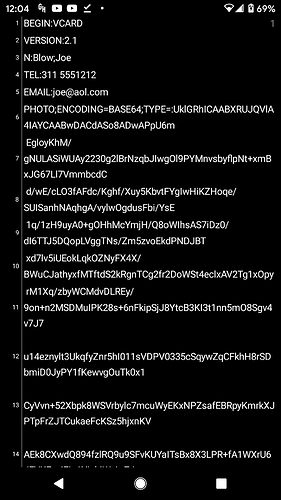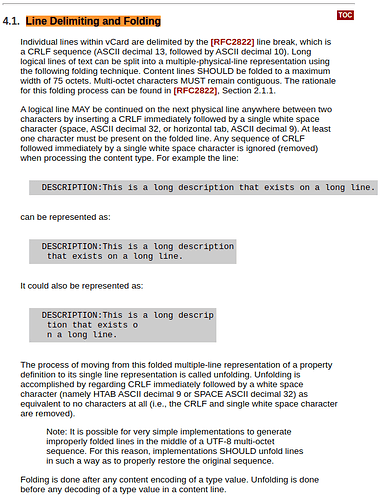Yep, that works perfect. No idea what’s going on. I’ll retry it a few more times and get back to you with my findings.
I haven’t done too much digging yet, and I’m just comparing the jpeg+webp script, not your new one, but there are some differences in my output compared to yours.
Yours:
Mine:
What’s your implant? How much space does the script say is available on the chip when you run it?
Hello fellow Oregon resident.
![]()
I’m really only running the script, moving the files to my phone, then testing to see if the vCard works. After I get one that works, I will then use TagWriter to write the ndef file to my NeXT.
In those two screen shots, I’m mainly talking about the base64…webp, yours doesn’t have that for some reason. Also all of the -en tags that mine does have.
I’m glad I’m not the only crazy one here ![]()
Try using my sample thing, then change one piece of information at a time. That should tell you quickly what the contact app is choking on.
Also, remember that the final NDEF should be 868 bytes or less to fit on your NeXT. It might be fine now, but the script will complain when time comes to write it if it’s any larger.
I will try that soon.
Also, do you sleep??
Not much these days…
Soooo, some progress…
There is a line in the script;
echo -en “\n $L” > > vcard.vcf
This is adding a new line with a -en in it. You can see these in the screenshots I posted before. These need to be removed, which also lessens the space, then I was able to run the ndeftool command and rebuild a new .ndef file:
$NDEFTOOL load --pack vcard.vcf tn text/vcard id ‘’ save --force vcard.ndef
Planning to upload soon ![]()
No they need to stay. Lines need to be folded and be max 75 characters. That’s in the specs.
However, now that you bring this up, I see I made another mistake: all the line terminators I use are LF, whereas the specs say they should be CRLF.
Or maybe I abused the format to save some space… Now I don’t remember…
Hmm… Time to correct some more ![]()
I didn’t mean that line needs to go, I just mean, I removed the -en and then deleted the empty line (see the screenshots) I just manually edited my output to look like yours and now the picture works.
I don’t have that USB writer you have, I can’t find an Android app that supports NDEF transfers, so I’m having some other issues now, joy…
Hmm I’m very confused… You do run this script on a standard Linux box with bash on it right? ![]() Because the -n in “echo -n” disabled the automatic LF. If yours inserts one, that would create empty lines, but it’s not normal.
Because the -n in “echo -n” disabled the automatic LF. If yours inserts one, that would create empty lines, but it’s not normal.
EDIT: here’s the version with the correct CRLF terminators:
vcard_writer_with_sample_information.zip (333.7 KB)
EDIT2: if your shell isn’t bash, or some messed up version of bash, try “echo -e -n” instead of “echo -en”. The -e switch enabled special characters, and the -n switch disables the normal echo linefeed. Normally it’s okay to specify both flags in one argument, but if your shell is dumb, it might take -en for something it needs to display - hence your LF-terminated “-en” lines.
Oh and yeah, one piece of advice: if you have an NFC implant, you really should get yourself an ACR122U. Everybody should have one. Honestly, it’s like a hunting knife: sure, strictly speaking you don’t need one to go out into the forest, but you do. Them readers are really good, very versatile, very well supported and dirt cheap.
Seriously brand new Kali 2021.3 live CD
I’ll think about it, I assumed I could just move the NDEF file to my phone, then use NFC Tools to just flash it straight over…I was mistaken.
I have proxmark lying around, I’ll try that tonight and if I still can’t get it to work, I’ll get a ACR122U. I’ve actually been wanting one for quick computer logins anyway
Well something funky is going on if your /bin/bash doesn’t understand echo -en ![]()
I’m not sure that the acr122u is what you want for that. But you should get one anyway.
Depending on the OS you might need a keyboard wedge instead like the KBR1.
Why? It’s much better than a keyboard wedge for that purpose. A keyboard wedge is what you use when you can’t use anything else.
Finally! Success!
I was able to create a small (122 byte) vCard with NFC Tools (Pro), write it to my hand, read it, export the “Tag Profile”, then email it to myself. This creates a JSON file that you can manipulate.
You’re mainly looking for the:
"BEGIN:VCARD\nVERSION:2.1\nFN:James annon\nTEL:503-555-5555\nEMAIL:…
I added \nPHOTO;, then started adding each line of the encoded photo followed by \n (new line). When you’re done, you have one long ass line of code that SHOULD work. Email it back to yourself, download it on your phone, go into NFC Tools, Write, More Options, Import Tag Profiles, find your downloaded JSON file, then Write it.
A little painful, but totally doable!
How do you configure Windows to use an ACR122U for NFC Authentication? I know you have suggested rohos before but you also mentioned that it broke at one point die to a windows update.
Rohos is not an option on my work computer, so are there alternatives? A keyboard wedge would work (although I am beginning to work on pulling out a password from the data on a chip and passing it in as keyboard data rather than using the UID).
If I recall, the Windows update broke the complicated serial setup I was using to fool Rohos into accepting dumb UIDs from my dumb serial readers. It didn’t break PC/SC. That works fine.
Okay so yeah, like I said, in cases like yours, the keyboard wedge is the only option. But those who have the option should use something else, is what I’m saying.


